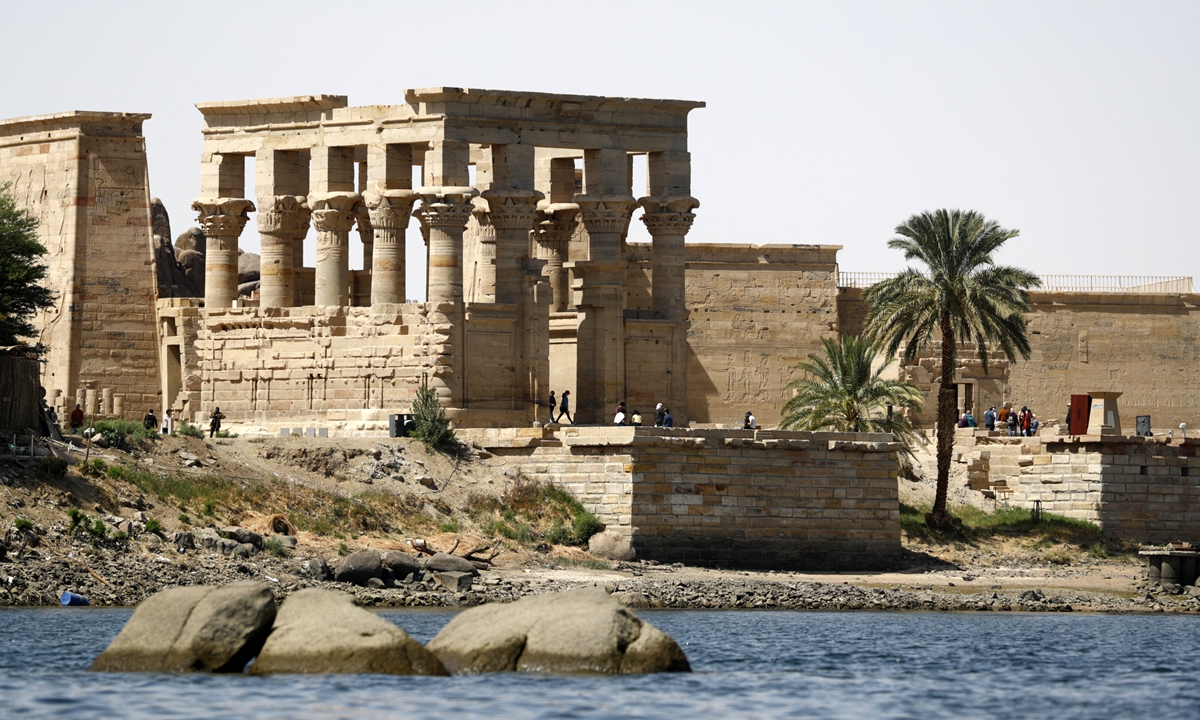
A picture taken on February 24, 2022, shows the Philae temple on a small island in the reservoir of the Aswan Low Dam in the city of Aswan in Upper Egypt, south of the capital Cairo. Photo: AFP
The flooding had become inevitable. Every winter, amid heavy rains and storms, the Mediterranean Sea would rise and spill over into fisherman Aziz Lasheen's low-lying village in Egypt's northern governorate of Kafr el-Sheikh.As water poured into the village of Mastroua it would destroy homes, saturate farmland with saltwater and cover the road Lasheen and others walked to reach their fishing boats.
"As fishermen and farmers, we were scared to go to work as the rising water covered up the shore. The tide was so high," the 33-year-old said.
That meant his income dropped by 70 percent every winter. "During that time of the year, I used to use my savings to afford my family's needs," he said.
But this past winter, Lasheen had no need to break into his savings, after the construction of a series of low-cost natural dikes to keep the surging waters away from his village during more and more violent storms along the Mediterranean coast.
Egypt, host of November's COP27 UN climate conference, is scaling up efforts to cushion the densely populated Nile Delta against the increasingly intense flooding that plagues low-lying areas around the world.
As part of a broader $105 million coastal management project led by the United Nations Development Programme (UNDP), the government is building a system of sand dikes along the shores of the Nile Delta to hold back the sea during stormy weather.
Stretching over nearly 70 kilometers, the dike system covers five governorates recognized as flooding hot spots - Kafr el-Sheikh, Beheira, Dakahlia, Damietta and Port Said.
The aim is to save the homes and livelihoods of 250,000 Nile Delta residents, said Mohamed Bayoumi, a climate change specialist with UNDP in Egypt.
Launched in 2019, the seven-year project has funding from the Green Climate Fund and the Egyptian Ministry of Water Resources and Irrigation. So far, nearly 70 percent of the system has been built, Bayoumi said in emailed comments.
"Without the current coastal protection work, the coastal areas are vulnerable to flooding," he said.
But some experts warn the dikes will only push the problem elsewhere, sending excess water from the protected areas along the Mediterranean coast to the rest of the Nile Delta, which fans out between the cities of Alexandria and Port Said.
"Protecting only the lowlands of the Nile Delta will turn them into small islands in the long term and will largely affect nearby lands and communities," said Abbas Sharaky, professor of geology and water resources at Cairo University.
"The whole area should be protected because the whole Nile Delta region is endangered by climate change, not only the lowlands," he said.
Since the dikes were built near his village in 2021, Lasheen said life has returned to normal, with fishermen again making a steady income and farmers back to growing crops.
Drowning breadbasket
As rising temperatures cause the world's ice sheets to melt faster and the ocean to warm and expand, coastal communities face more frequent flooding and harsher storms that drive powerful seawater surges inland, scientists from the Intergovernmental Panel on Climate Change said in a 2019 report.
Home to about a quarter of Egypt's population, according to the UNDP, the Nile Delta - known as Egypt's breadbasket - contributes about 20 percent of the country's gross domestic product through agriculture, industry and fishing.
A government report released in 2021 pointed to rising sea levels and flooding among various factors that could cause wheat production in Egypt to drop by 15 percent and rice production to fall by 11 percent by 2050.
As it tries to stop that from happening, the government is turning to low-cost dikes designed to look like natural dunes.
Made out of beach sand brought inland, the barriers are planted with reeds and local vegetation to help boost biodiversity and encourage them to grow bigger and stronger by trapping blown sand.
In that way, they also help combat erosion, another major factor in increased flooding in the delta, said Jan Dietrich, a project team leader at Danish engineering consultancy NIRAS.
Dietrich heads up another part of the UNDP initiative, Egypt's integrated coastal zone management (ICZM) plan.
The plan, "one of the most extensive of its kind in the world," he said, involves a range of projects - including a new sea level monitoring system - to address flooding, saltwater intrusion, erosion and other problems.
Since the first stage of construction on the Aswan High Dam was completed across the Nile in 1964, less sediment has traveled downriver to naturally fortify the Mediterranean coast, allowing the sea to creep further inland, Dietrich said.
Amid worries that the new sand barriers could also be vulnerable to erosion, UNDP's Bayoumi said the Shore Protection Authority will be in charge of maintaining the dike system across Egypt.
Reuters
